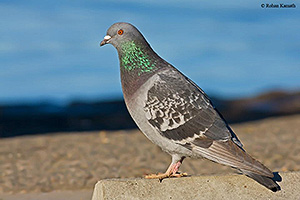Navigation and Orientation |
|
|---|---|

photograph of a Rock Dove by Rohan Kamath |
The
question of how birds find their way between breeding and
wintering grounds has puzzled people for as long as they
have been aware of the phenomenon of migration. Today we
know many more parts of the puzzle's solution than we did
even twenty-five years ago. Some would argue that there are
really two puzzles: (1) how birds navigate over thousands of
miles to find their way between breeding and wintering
sites, and (2) how birds find their way back to precise
nesting or roosting sites (homing behavior). To do either,
birds must be able to orient (that is, determine compass
direction) and to navigate (judge their position while
traveling). The short explanation of these complex phenomena is that birds find their way by using a variety of cues in a hierarchical fashion. Different species may use these cues |
| in different orders of priority,
and some cues may always be used in preference to others.
Birds acquire directional information from five primary
sources: (1) topographic features, including wind direction
which can be influenced by major land forms, (2) stars, (3)
sun, (4) Earth's magnetic field, and (5) odors. Some of the most convincing experiments demonstrating the navigational abilities of birds were performed by behavioral ecologist Stephen Emlen. He took advantage of the "migratory restlessness" of caged migrant birds -- fluttering and hopping that tend to be oriented in the direction of migration. Using Indigo Buntings in a planetarium, Emlen found that the birds oriented in the proper migratory direction using the stellar cues projected onto the planetarium ceiling. When Emlen shifted the position of the planetarium's stars, the birds shifted their orientation as well. The buntings were shown to learn a "sky map" as they watch the rotation of the stars while they grow up. The young birds learn to recognize the area of least apparent movement around the pole; if maturing buntings were exposed to a false sky rotating around the star Betelgeuse (in the constellation Orion), they acted as if Betelgeuse were the North Star. But how do birds find their way on overcast nights? Apparently, they are able to set course by the setting sun, unless this too is obscured by cloud cover. Lacking either stars or sun for information, birds will orient by wind direction, although not always correctly. Ornithologist Kenneth Able used radar and portable ceilometers (electronic devices for measuring the altitude of overcasts) to track nocturnal migrants and reported that birds frequently flew in the wrong direction by using wind as a cue when stars were unavailable. Interestingly, while most ornithologists believe that birds employ topographic features like mountains, rivers, tall buildings, etc., to navigate in the vicinity of the home site, there is little evidence of the use of such cues. Recent experiments have revealed that pigeons are capable of detecting the Earth's magnetic field and can use it to orient and possibly to navigate. We still do not understand just how pigeons manage to sense such weak electromagnetic fields, but birds are far more sensitive to them than are human beings. We have yet to learn how widespread this ability may be among other species of birds. Homing pigeons, in addition to sensing magnetic fields, recently have been shown to use smell for at least short-distance orientation in returning to their loft. Earlier studies indicated that Leach's Storm-Petrels (and probably other "tubenoses") might possibly use their sense of smell to locate their nest burrows, although they rely on other cues to find the colony. Shearwaters, like pigeons, are capable of spectacular homing feats. Many Shearwaters were taken from their nest burrows off the coast of England, transported across the Atlantic Ocean, and released near Boston. Twelve and a half days later some of these individuals were back in their nest burrows. How they accomplished the feat is unknown, but they certainly didn't sniff their way home. One clear message emerges from studies of avian orientation and navigation: birds do not rely on a single source of information to guide them on their travels. Instead, they possess the ability, shaped over evolutionary time, to use redundant cues from a variety of sources. Such a system enables birds to find their way under most conditions that they routinely encounter. |
|
| SEE:
Migration;
The Avian Sense of Smell;
How Do We Find Out About Bird Biology? Copyright ® 1988 by Paul R. Ehrlich, David S. Dobkin, and Darryl Wheye. |
|